🌲 Climate Change: Planting Trees
🥵 Some Solutions to Climate Change, Part 2
Climate change is upon us, and we want to do something about it. Why not plant a few trees?
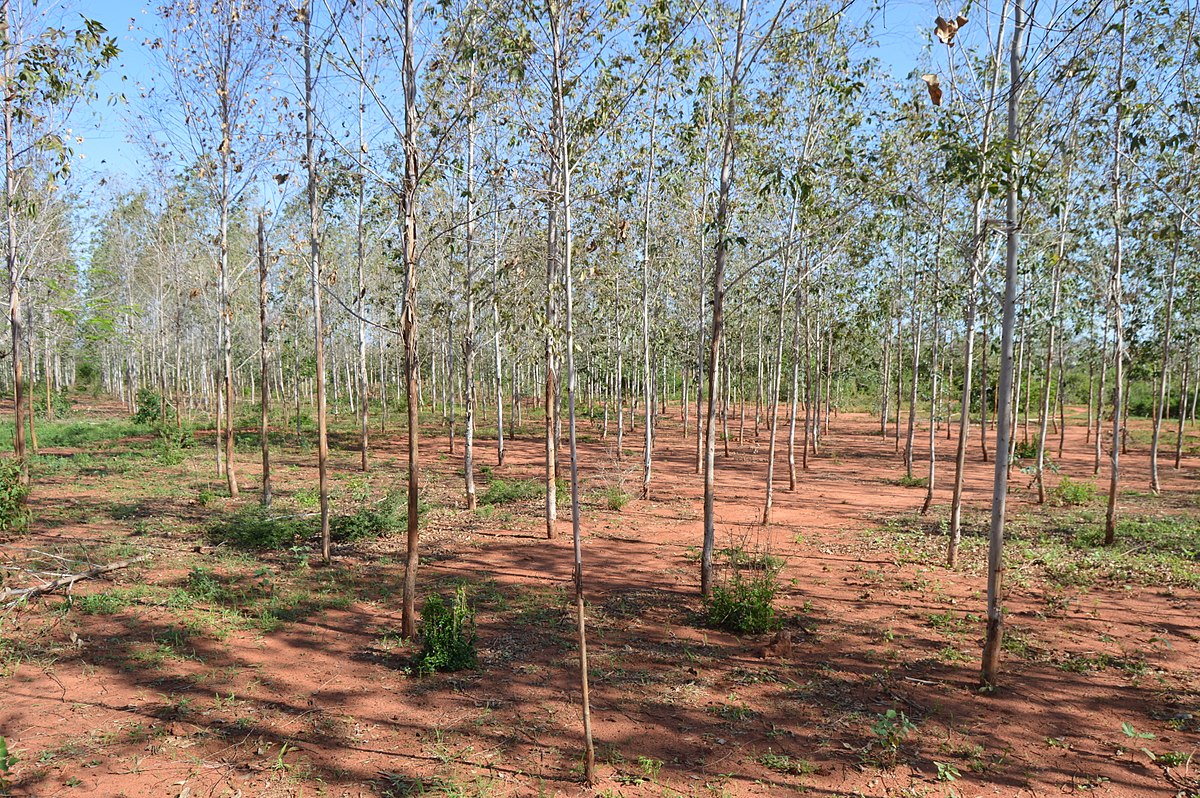
🌲 Lots of Trees
Some people are proposing a solution to climate change which can be a bit disappointing: just planting trees. Maybe you are now thinking: “Bloody hippies! Use technology!” You probably prefer to think of clever carbon-capture devices that could turn the tide and suck all that carbon out of the skies, using modern technology. Problem is, none of it works properly yet, and possibly will never work. Until it does, why not use low-tech solutions?
As it happens Mother Nature has created these wonderful machines that have evolved during millions of years to become better at basically one thing: convert CO₂ to carbon in their trunks. This is exactly what we need now! In the process they also generate sugars, create seeds and deter hungry animals, plus give shade and provide for excellent furniture. But these are secondary interests.
Just how many trees can we realistically plant in the world? Many areas are already covered in forests; others are deserts. Of the remaining areas, many are used for growing food; there are also cities and roads. We can of course plant trees in many of these places: as hedges in fields, in our streets, even on top of buildings. There are also many areas without any tree cover at all.
Some studies say that a trillion (10^12) trees are feasible, like this one by Crowther et al or this one by Bastin et al. Note that some of the authors are repeated in both studies, that they were already experts in counting trees, and that some of their conclusions are disputed, as we will see below. But for now let’s say that the project is possible, just for the sake of argument.
Note: throughout the article I’m using US billions (10^9, or a thousand millions) and US trillions (10^12, or a million millions).

As it happens, some people took it seriously, including Trillion Trees, another Trillion Trees, and the World Economic Forum. It’s such a catchy name!
Another very interesting possibility is using algae, which are even more efficient in converting CO₂ to carbon because they already have all the necessary water in their surroundings. These techniques are very likely more difficult to implement than just planting trees, and can have other side effects. So we will focus on trees.
⚡ Efficiency
Let us approach the matter from a different perspective: just how many trees do we need? We will do a Fermi estimation, which should give us an approximate solution (or technically, the right order of magnitude).
We will divide the problem into three simpler steps: find out total
excess carbon in the atmosphere T(C), how much carbon each
tree can absorb m(C), and the number of trees
N(trees). Our problem will be solved when we plant enough
trees to absorb all of the excess carbon in our atmosphere, in
equations:
T(C) = m(C) × N(trees),or solving for number of trees:
N(trees) = T(C) / m(C).That’s it! Problem solved, Earth saved.
🛢️ Total Excess Carbon
First let’s estimate the total amount of excess carbon in the atmosphere. If we look at the data from Our World in Data, there is a more or less steady linear increase from around 1945 to 2021. (Yes, emissions are still increasing, we are that clever.) Latest numbers are 37 billion metric tons of CO₂.
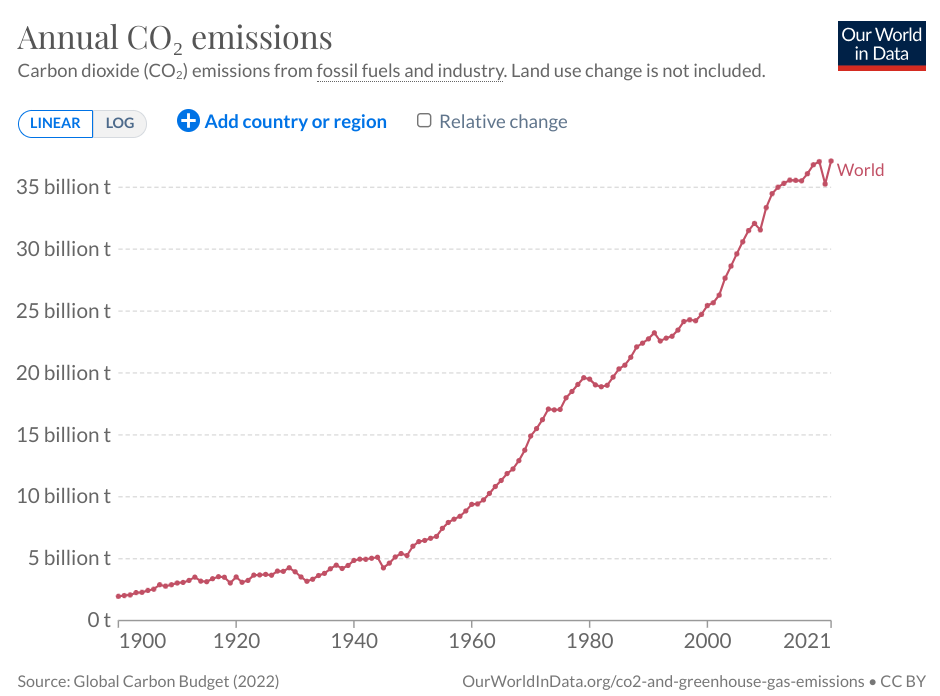
Say we have a completely linear graph from 1940 to 2020 (80 years), the total of carbon emissions would be something like the number of years multiplied by the midpoint:
T ≈ 80 × 40 / 2 GtCO₂ ≈ 1600 GtCO₂.Remember, for now we don’t have to get an exact number, just a rough estimation, so we can round our numbers to make them easier to deal with. Let’s convert to the international system, remembering that the prefix giga means 10^9 and a ton is just a million grams:
T(CO₂) ≈ 1600 × 10^9 × 10^6 g ≈ 1.6 × 10^18 g.How much carbon is that exactly? A molecule of CO₂ has one atom of carbon (C) with atomic weight 12 and two oxigens (O) each with atomic weight 16; the total portion of carbon is thus 12/(12+16+16) ≈ 27%:
T(C) ≈ 0.27 × 1.6 × 10^18 g ≈ 0.4 × 10^18 g.Or a little bit under half a million million million grams. The official name is “half an exagram”, although we can call it more familiarly “half a teraton”, which has more punch. In the press you will find numbers as 400 gigatons of carbon, which is nice because they are easily manageable.
Some part of that carbon has by now been absorbed by the oceans and other natural processes, but we can assume that most of it remains floating around. In any case we want to go back to our beautiful, uncarbonized world of 1940, minus the world war raging at the time, I guess.
Good! We are getting there.
🪵 Carbon per Tree
Now let’s estimate how much carbon we can store in a tree. Let’s assume an average 6 meter tall tree, with a trunk diameter of 40 cm (i.e. radius is 0.2 m). Remembering the formula for the volume of a cylinder:
V(cylinder) = π × radius × radius × height,this gives us a volume V(trunk) of:
V(trunk) ≈ π × 0.2 m × 0.2 m × 6 m ≈ 0.75 m³.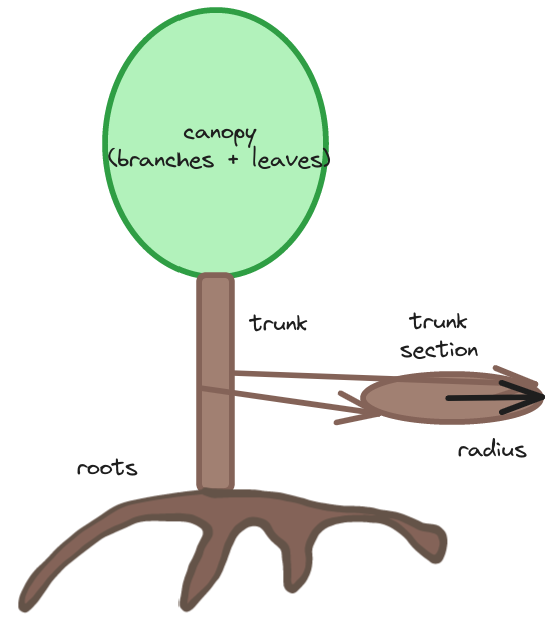
A bit below one cubic meter of trunk. How much does each tree trunk weigh? Wood has a density similar to water (some woods float, others don’t), which is 1 kg per liter (a cube with sides of 10 cm), so our average tree trunk will weigh:
m(trunk) = d × V ≈ 1 kg / 0.001 m³ × 0.75 m³ ≈ 750 kg.A bit below a metric ton (1000 kg). But the tree also has branches and leaves and roots; we can estimate that the trunk is just half the total weight, which is probably not that far off.
Therefore we will have twice as much mass in the whole tree as in the trunk: around 1.5 metric tons. But only around half of the tree will be carbon, so we will stick to 750 kg of carbon per tree, close to a metric ton, or a bit under a million grams:
m(C) ≈ 0.75 × 10^6 g.How close are we to official estimations? Well, taking Spain as an example: there are seven billion trees, which together store 422 million metric tons of carbon; each tree will hold
m(C)' = 422 × 10^6 mt / 7 × 10^9 = 0.060.Around 60 kg per tree; our solution is off by more than an order of magnitude! Keep in mind that every tree above 75 mm of diameter is counted in the above inventory, while we are considering mature 6 meter tall, 40 cm wide trees. So we can go ahead with our estimation for rather largish trees.
🌳 Number of Trees
Finally, can we plant enough trees? Is there even space for them?
As we saw at the beginning, to remove all excess carbon from the atmosphere we need a grand total of:
N(trees) = T(C) / m(C) ≈ 0.4 × 10^18 g / 0.75 × 10^6 g ≈ 0.5 × 10^12.Or around half a trillion trees. Can we find a place for them all? As we saw above, many studies have looked at this question, with varied answers. Here we will just do our own Fermi estimation.
Let’s take first Spain as an example. With a total area of roughly half a million square kilometers it has a good forest cover of over 30%; another ~30% is arable lands; the rest is pastures, mountains, cities, roads and arid lands.
Let us suppose we can cover this 30% with trees every 10 meters. (A bit dense but not uncommon.) After all, according to legend Strabo wrote that a squirrel could cross Spain from Gibraltar to the Pyrennes without touching the ground. A grid of trees spaced 10 meters would yield 100 × 100 = 10000 trees per square kilometer.
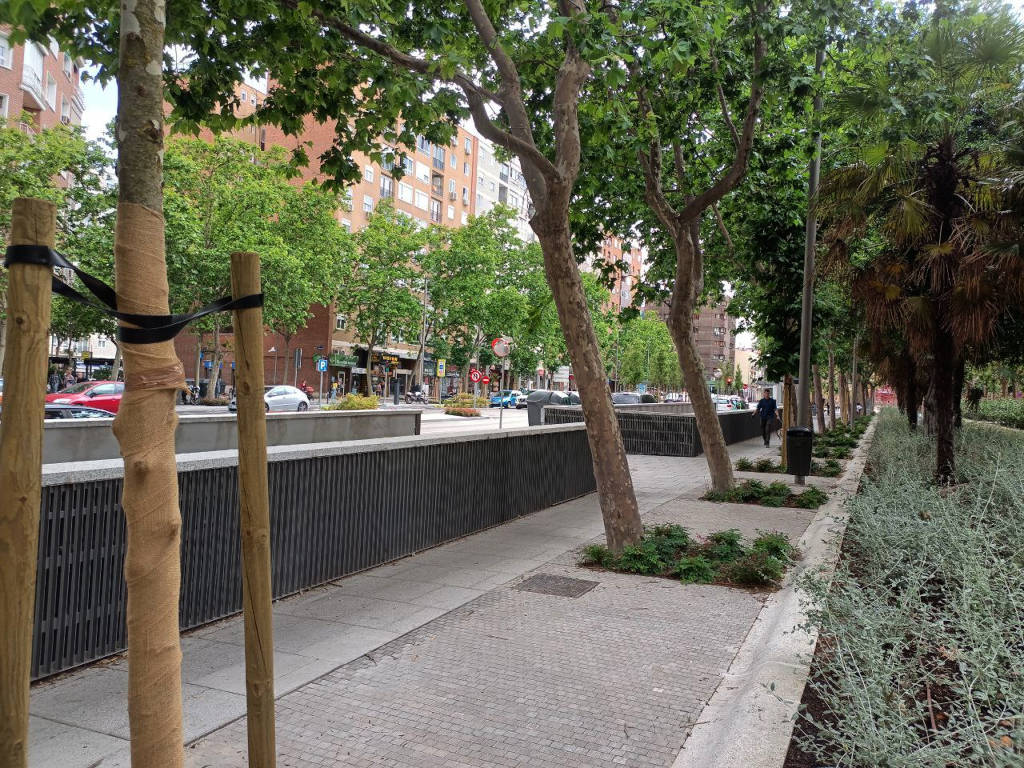
The total for Spain would be:
N(Spain) = 30% × A(Spain) × n(km²) ≈ 30% × 500000 × 10000 ≈ 1.5 × 10^9.We could plant a little over a billion trees. How much carbon is that?
T(Spain) = N(Spain) × m(Spain) ≈ 1.5 × 10^9 × 0.75 mt,equivalent to around 1 gigaton of carbon. Again, let us check with official sources if our estimations are off the mark. Remember that Spain’s forests contain 422 million metric tons of carbon; in 36% of the surface; it seems ambitious to store 1 gigaton in the remaining 30%. But not all is lost! According to the Copernicus project, Spanish forests store overall around 2.5 gigatons of carbon; four times more below the ground than in the trees themselves.
Now let us replicate our reforestation project to the whole world. Total land area is around 150 million km²; using the same proportion we would get:
N(world) = 30% × A(land) × n(km²) ≈ 30% × 150 × 10^6 × 10^4 ≈ 0.45 × 10^12.Almost exactly our half a trillion trees! Very roughly our project should be feasible.
🎚️ Some Checks
The climate scientist Thomas Crowther, cited above, estimates that there are around 300 gigatons of excess carbon in the atmosphere. We estimated 400 gigatons above, so not bad!
In 2019 there were some publications about the trillion trees, saying that such a project would suck the equivalent carbon of a decade of emissions, when according to our estimation it could wipe out all the excess carbon. Bastin et al later corrected that it might wipe out up to two thirds of all carbon, closer to our estimate. I suspect that the difference stems from the basic confusion between tons of CO₂ and tons of carbon. We need to be extra careful with what kind of gigatons are we speaking about at each point: carbon or CO₂?
🌐 Massive Scale
Is it even possible to physically plant one million million trees? Crowther says:
if you started planting 2000 years ago and planted a million trees every day, […], after more than 2000 years of daily planting at that massive scale, you’d still be under three quarters of the way to one trillion trees!
Very nice Fermi estimation there, mate! Although let me point out that there are 7 billion people interested in stopping climate change; it makes no sense to do some centralized project with one agency doing all the work. If we pay a million people to plant one tree per minute, or a thousand per day, the job would be done in about three years (a thousand days).
What about the possibility of planting so many trees? Apparently semiarid zones cover 17.7% of the globe, and they might be the prime targets for reforestation. Not so far from the 30% we needed; plus other areas (like the dry subhumid with 9.9% of the surface, or the agricultural soil) might help.
Project Drawdown is a project to categorize and quantify possible solutions to climate change. They have a number of projects related to forests, among them tree plantations accounting for 22 gigatons of CO₂, All of them combined are 217 gigatons of CO₂, or less than 55 gigatons of carbon; quite disappointing when compared to the excess ~1200 gigatons (of CO₂) we have to deal with. I am not sure they are ambitious enough, but maybe our little plan is not feasible. We should definitely strive to make it possible.
💊 Side Effects
The side effects of planting a lot of trees are generally very nice: having a lot of trees. They cool the surroundings, help fixate the ground and provide a living environment for other creatures. In cities they lower the temperature of a street by at least five degrees in summer. Allow me to recommend this very nice infographic from Reuters on the subject.
Not everyone is happy though. There were quite a lot of objections to these “trillion trees” projects, from ecosystem degradation to questions about the amount of carbon sucked in.
There’s the matter of albedo (or proportion of sunlight reflected): trees are generally darker than rock, and therefore can negate some of the benefits of carbon capture by absorbing heat. On the other hand it is well known that trees attract rain, increasing the cloud cover and decreasing the albedo. It is not easy to guess which way the net heat gain will go. This is a complex issue far beyond what we can explore here; we will leave it for people with complex models.
🐟 Extra Carbon Sleeps with the Fish
Another question is: what do we do with all that carbon once it is stored in trees? If we just leave it there then there is a limit to the carbon taken from the atmosphere; and it might burn at some point getting us back to the starting point.
As we saw above, each tree (including branches) would have a volume of around 1.5 m³. All these trees would make up a cube with sides of approximately 9 km:
V(world) = N(world) × V(tree) ≈ 0.5 × 10^12 × 1.5 m³ = 0.75 × 10^12 m³ ≈ (9 km)³.What can we do with a cube of side 9 km? One possible extension of the program might be to mow down trees from time to time and dispose of them, for example by burying them or throwing them into the sea. It might be a challenge to find trenches deep enough to bury so much wood though.
The Mariana Trench is 11 km deep, so maybe we can dump a teraton of wood down there? To be fair it would not be nice to the existing ecosystems; there are bacteria and even fascinating giant amoeba that measure up to 10 cm long. But we are trying to prevent a giant ecological catastrophe here, so all things considered it may be worth it. The trench is about 2550 km long so not everything needs to go into the deepest point.
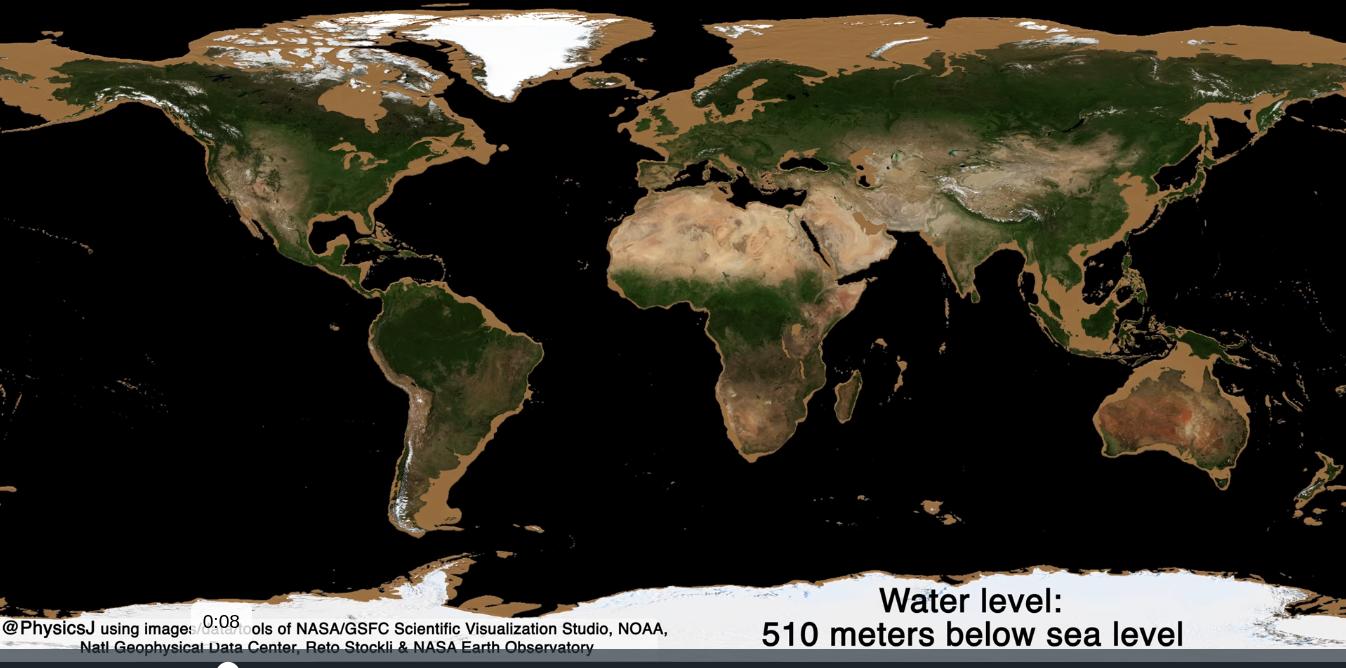
Ideally we would find local trenches so we don’t need to ship all trunks to the Pacific Ocean. Also, apparently the pressure would flatten anything beyond a certain depth, so we might fit essentially infinite trees in a deep enough trench. These trees might even become oil in a few million years!
One final point: most wood does not float, but that is just because it contains air. Simply keeping it in water for a few weeks is enough to make it sink.
🪓 Cheap Wood
Maybe we can even convert some of these trees into furniture and store them in our homes! With 2 billion households in the world, storing half a metric ton of carbon per house would clear around one gigaton of carbon. Not much, but every bit helps.
There are many things that we can do with cheap wood. Perhaps the world would start using more for construction, like in the US. I’m sure I’m not alone in wanting to have more things built of this noble material.
🤔 Conclusion
I hope that every time you pass by a mountain or a hill without trees you will think “that sucker could sequester millions of tons of carbon”, like I do now. We are in the midst of a global emergency that will need to be addressed by many different means; and trees can be our number one ally as they have been for millions of years. Even if they don’t solve the underlying problem, they may help us fight its worst consequences.
⏭️ To Be Continued
This is the second part of the series about climate change.
- Part 1: 🥵 Some Solutions to Climate Change,
- Part 2: 🌲 Planting Trees,
- Part 3: 🪩 Mirror Roofs,
- Part 4: 🛰️ Space Screens,
- Part 5: 🤔 Conclusion: Taking Action.
Enjoy!
Published on 2023-06-17, last modified on 2023-08-08. Comments, suggestions?
Back to the index.